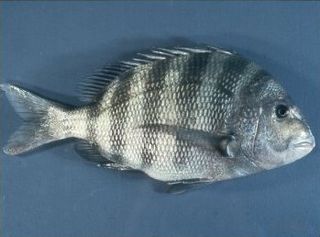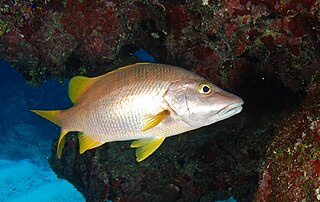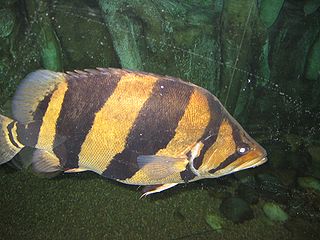
Archosargus probatocephalus, the sheepshead, sheepshead seabream or convict fish, is a species of marine ray-finned fish belonging to the family Sparidae, the seabreams and porgies. This species is found in the Western Atlantic Ocean. The sheepshead is an important species to recreational and commercial fisheries.

The Atlantic goliath grouper or itajara, also known as the jewfish, is a saltwater fish of the grouper family and one of the largest species of bony fish. The species can be found in the West Atlantic ranging from northeastern Florida, south throughout the Gulf of Mexico and the Caribbean Sea, and along South America to Brazil. In the East Pacific it ranges from Mexico to Peru. In the East Atlantic, the species ranges in West Africa from Senegal to Cabinda. The species has been observed at depths ranging from 1 to 100 meters.

The crevalle jack, also known as the common jack, black-tailed trevally, couvalli jack, black cavalli, jack crevale, or yellow cavalli is a common species of large marine fish classified within the jack family, Carangidae. The crevalle jack is distributed across the tropical and temperate waters of the Atlantic Ocean, ranging from Nova Scotia, Canada to Uruguay in the western Atlantic and Portugal to Angola in the eastern Atlantic, including the Mediterranean Sea. It is distinguishable from similar species by its deep body, fin colouration and a host of more detailed anatomical features, including fin ray and lateral line scale counts. It is one of the largest fish in the genus Caranx, growing to a maximum known length of 124 cm and a weight of 32 kg, although is rare at lengths greater than 60 cm. The crevalle jack inhabits both inshore and offshore waters to depths of around 350 m, predominantly over reefs, bays, lagoons and occasionally estuaries. Young fish dispersed north by currents in the eastern Atlantic are known to migrate back to more tropical waters before the onset of winter; however, if the fish fail to migrate, mass mortalities occur as the temperature falls below the species' tolerance.

Lobotes is a genus of ray-finned fishes belonging to the family Lobotidae known as the tripletails. These fishes are found in subtropical and tropical waters in all oceans.

Lobotidae is a family of ray-finned fishes that includes the tripletails, which are circumtropical marine fishes, and tiger perches, which are Asian freshwater fishes. The family is placed in the order Spariformes in the 5th edition of Fishes of the World but this classification and the taxa included within the family is not agreed on by all workers.

The gag grouper, also known as velvet rockfish, the gag, or charcoal belly, is a species of marine ray-finned fish, a grouper from the subfamily Epinephelinae which is part of the family Serranidae, which also includes the anthias and sea basses. It comes from warmer parts of the West Atlantic, including the Caribbean and Gulf of Mexico. It is a drab, mottled-gray fish lacking the distinguishing features of most other groupers. Its pattern of markings resemble the box-shaped spots of the black grouper. It lacks the streamer-points on the tail fin that scamp and yellowmouth grouper have and lacks yellow coloration around the mouth.

The blue runner, also known as the bluestripe jack, Egyptian scad, hardtail jack or hardnose, is a common species of moderately large marine fish classified in the jack family, Carangidae. The blue runner is distributed across the Atlantic Ocean, ranging from Brazil to Canada in the western Atlantic and from Angola to Great Britain including the Mediterranean in the east Atlantic. The blue runner is distinguished from similar species by several morphological features, including the extent of the upper jaw, gill raker count and lateral line scale counts. The blue runner is known to reach a maximum length of 70 cm and 5.05 kg in weight, but is much more common below 35 cm. The species inhabits both inshore and offshore environments, predominantly over reefs, however it is known to congregate around large, man-made, offshore structures such as oil platforms. Juveniles tend to inhabit shallower reef and lagoon waters, before moving to deeper waters as adults.

The Atlantic tarpon is a ray-finned fish that inhabits coastal waters, estuaries, lagoons, and rivers. It is also known as the silver king. It is found in the Atlantic Ocean, typically in tropical and subtropical regions, though it has been reported as far north as Nova Scotia and the Atlantic coast of southern France, and as far south as Argentina. As with all elopiformes, it spawns at sea. Its diet includes small fish and crustaceans.

The schoolmaster snapper, is a species of marine ray-finned fish, a snapper belonging to the family Lutjanidae. It is found in the western Atlantic Ocean. Like other snapper species, it is a popular food fish.

The bigeye trevally, also known as the bigeye jack, great trevally, six-banded trevally and dusky jack, is a species of widespread large marine fish classified in the jack family Carangidae. The bigeye trevally is distributed throughout the tropical waters of the Indian and Pacific Oceans, ranging from South Africa in the west to California and Ecuador in the east, including Australia to the south and Japan in the north. The bigeye trevally is best distinguished by its colouration, having a dark second dorsal fin with a white tip on the lobe, and also possessing a small dark spot on the operculum. Other more detailed anatomical features also set the species apart from other members of Caranx. The species is known to grow to a length of 120 cm and 18 kg.

The rainbow runner, also known as the rainbow yellowtail, Spanish jack and Hawaiian salmon, is a common species of pelagic marine fish of the jack family, Carangidae. The species is widespread throughout the tropical and subtropical waters of the world, inhabiting both coastal and offshore areas. The species is the only member of the genus Elagatis, which was created 15 years after its initial description, and is closely related to the amberjacks. The rainbow runner is easily distinguished by its body shape, and the brilliant colouration which gives the fish its name. It is a fast-swimming predator, taking small fish, cephalopods, and a wide variety of planktonic crustaceans. The species reaches sexual maturity around 60 cm (24 in), and spawning takes place at different times, with some populations spawning year round, while others only spawn at certain times of the year. The species is a well known game fish, taken by a variety of fishing methods, and is a well-regarded table fish. Large numbers of the species are taken as bycatch in tuna- and shark-fishing operations and marketed.

The greater amberjack, also known as the allied kingfish, great amberfish, greater yellowtail, jenny lind, Sea donkey, purplish amberjack, reef donkey, rock salmon, sailors choice, yellowtail, and yellow trevally, is a species of predatory ray-finned fish in the family Carangidae, the jacks and pompanos. It is found in temperate, subtropical, and tropical seas around the world. It is a popular quarry species for recreational fisheries and is important in commercial fisheries. It is the largest species in the family Carangidae.

Anisotremus virginicus, the porkfish, also known as the Atlantic porkfishsweetlips, dogfish or paragrate grunt, is a species of marine ray-finned fish, a grunt belonging to the family Haemulidae. It is native to the western Atlantic Ocean.

The Siamese tigerfish, also known as the Siamese tiger perch, is a species of ray-finned fish belonging to the family Lobotidae, the tripletails and tiger perches. This fish is endemic to Indochina and is assessed as Critically Endangered by the IUCN.

The blackfin snapper, also known as the blackspot snapper, blackfin red snapper, gun-mouth backfin, gun-mouth snapper, redfish and wrenchman is a species of marine ray-finned fish, a snapper belonging to the family Lutjanidae. It is native to the western Atlantic Ocean. It is a commercially important species, though it has been reported to carry the ciguatera toxin.

The black margate, also known as black bream, black thicklip, dogfish, lippe, Mexican bull, pompon, Spanish grunt, surf bream, sweetlips or thicklip grunt, is a species of marine ray-finned fish, a grunt belonging to the family Haemulidae. It is native to the western Atlantic Ocean.

Datnioides microlepis, also known as the Indonesian tiger perch, Indo datmoid, Indonesian tigerfish, or finescale tigerfish, is a species of freshwater ray-finned fish belonging to the family Lobotidae, the tripletails and tiger perches. This species is endemic to the Malay Peninsula and Indonesia.

Datnioides undecimradiatus, the Mekong tiger perch is a species of freshwater fish belonging to the family Lobotidae, the triplefins and tiger perches. This species is endemic to the lower and middle Mekong basin in Indochina.

Datnioides polota, the silver tigerfish, silver tiger perch, barred tigerfish, fourbanded tripletail, fourbanded tigerfish or fourbarred tigerfish, is a species of ray-finned fish belonging to the family Lobotidae, the tripletails and tiger perches. This fish is found in southern Asia and New Guinea.

Lobotes pacifica, the Pacific tripletail or West Coast tripletail, is a species of marine ray-finned fish belonging to the family Lobotidae, the tripletails and tiger perches. This species is found in the eastern Pacific Ocean.
























